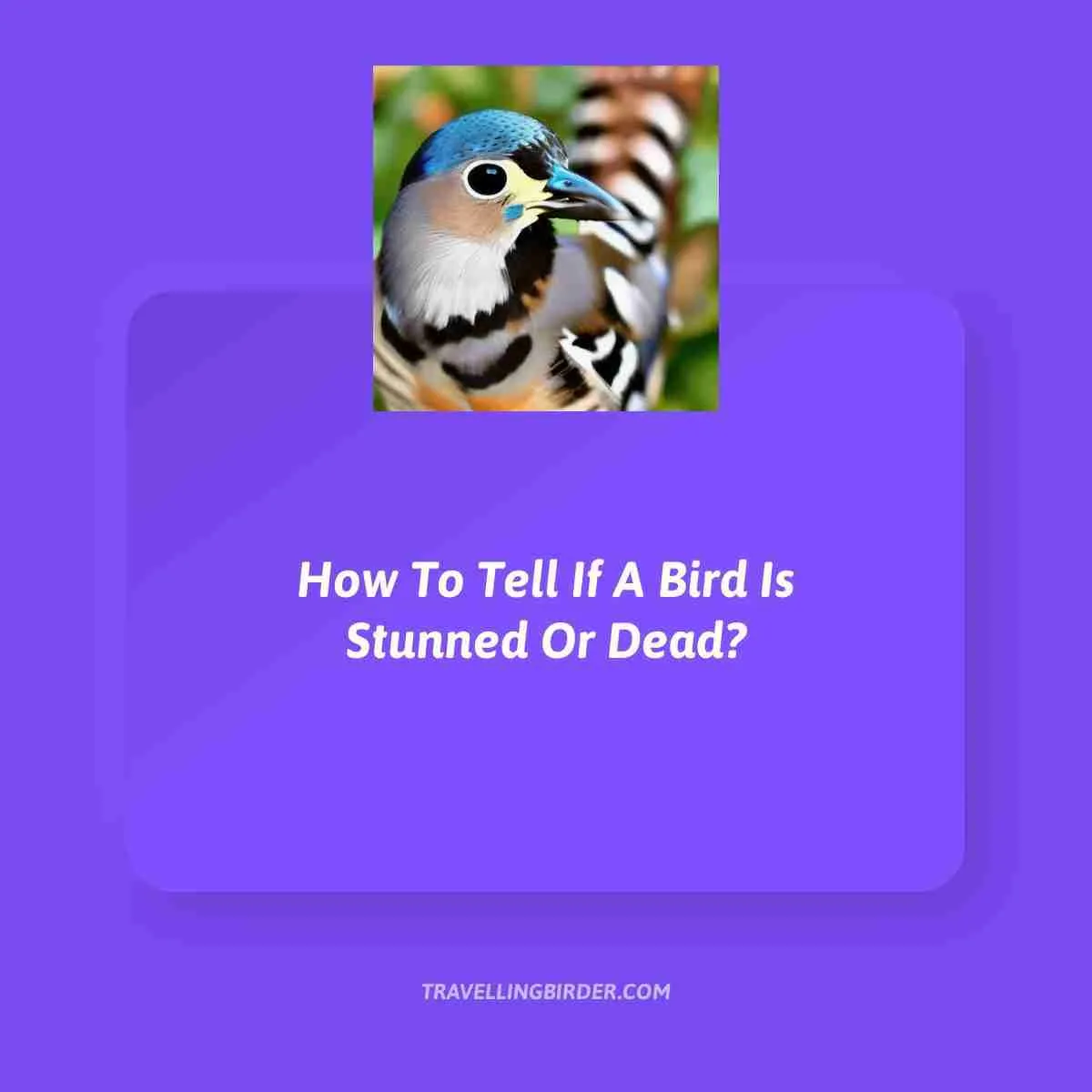We’ve all been there – you’re walking along, minding your own business when suddenly you come across a bird lying on the ground. It’s not moving and it doesn’t seem to be breathing. Your heart sinks as you wonder if it’s dead or just stunned.
You want to help, but how can you tell the difference? Don’t worry; in this article, we’ll walk you through some simple steps that will help you determine whether our feathered friend is taking an unexpected nap or has met its untimely end.
It’s important to act quickly, as time may be critical for a stunned bird’s survival. But before diving into action, let’s make sure we understand what could cause a bird to become stunned in the first place. From window collisions to encounters with predators, there are numerous reasons why birds might find themselves in such a vulnerable state.
Once we know how to identify these signs of distress, we’ll have a better chance at helping them recover – or giving them proper respect if they didn’t make it through their ordeal alive. So read on and arm yourself with knowledge that might just save a life!
Identifying Causes Of Bird Stun
Identifying the causes of a bird being stunned is essential for determining whether it’s alive or dead.
One common cause of bird stun is collisions with windows, buildings, and other structures; these accidents can leave birds temporarily disoriented and unresponsive.
In such cases, implementing measures like window decals or reducing light pollution can help in stun prevention.
After understanding potential reasons behind a bird’s stun, you’ll need to examine the creature closely by checking for visible signs of life to determine its condition accurately.
Checking For Visible Signs Of Life
Now that you’ve gained an understanding of potential causes for a bird to be stunned, it’s crucial to look for visible signs of life.
Examining the feather condition can give you vital information about the bird’s state; ruffled or puffed-up feathers may indicate stress or injury.
Additionally, performing a gentle heartbeat check by carefully placing your fingers around its chest can help determine if the bird is alive. Remember not to apply too much pressure when checking for a heartbeat as this could cause further harm.
Following these steps will aid in determining whether the bird is merely stunned or has sadly passed away.
Next, we’ll delve into assessing the bird’s breathing patterns and what they might reveal about its condition.
Assessing The Bird’s Breathing
Let’s start by looking at the chest movement, then we can listen for breath sounds.
We can figure out if a bird is stunned or dead by observing and listening carefully.
Observing The Chest Movement
Isn’t it fascinating to watch birds fly around and sing their beautiful melodies?
Unfortunately, at times we may encounter a bird that appears lifeless or injured.
One crucial step in determining if the bird is dead or merely stunned is by observing its chest movement for signs of breathing.
Carefully examine the bird’s body; you’ll want to pay close attention to any subtle movements indicating avian respiration patterns.
By focusing on this chest rise observation, you can determine whether the unfortunate creature still has a chance of survival or has tragically passed away, allowing you to take appropriate action towards helping our feathered friend.
Listening For Breath Sounds
Now that we’ve established the importance of observing chest movements in determining a bird’s life status, another vital aspect to consider is listening for breath sounds.
As if you’re becoming a bird whisperer, gently place your ear near the creature’s beak and pay close attention to any audible respiration signs.
Remember, birds have smaller lungs and air sacs compared to mammals, so their breathing might not be as loud or apparent.
By combining visual observations with avian resuscitation techniques such as listening to breath sounds, you’ll significantly increase your chances of correctly assessing the situation and knowing how best to help our feathered friend in need.
Don’t underestimate this essential step; it could make all the difference in saving a precious life!
Monitoring The Bird’s Response To Stimuli
To determine if a bird is stunned or dead, it is essential to observe its reaction to various stimuli. Pay close attention to the bird reflexes and sensory reactions as this can provide vital clues about their condition.
Here are some indicators to look for:
- Touch response: Gently touch or prod the bird with a soft object like a pencil eraser; if alive, it should react by trying to move away from the stimulus.
- Eye movements: Observe the eyes of the bird; they should be blinking or showing signs of awareness in case of a living bird.
- Breathing patterns: Look closely at the chest area of the bird; you should notice rhythmic movement indicating breathing.
- Leg and wing movements: When gently stimulated, wings and legs should show some resistance or movement if the bird is still alive.
After carefully evaluating these responses, you will have a better understanding of whether the bird is merely stunned or has unfortunately passed away. With this information in hand, proceed towards safely handling and assisting a stunned bird in need.
Safely Handling And Assisting A Stunned Bird
When you come across a bird that is stunned or injured, it’s crucial to employ gentle handling techniques to prevent further harm. Firstly, make sure your hands are clean and dry before attempting to pick up the bird. Carefully approach the bird from behind and gently cover its body with one hand while supporting its head with your other hand. Once you have a secure hold on the bird, prepare a recovery box by lining a small cardboard box with soft materials such as tissue paper or an old towel.
| Emotional Response | Action Taken | Outcome |
|---|---|---|
| Panic | Grabbing the bird too roughly | Further injury |
| Empathy | Gentle handling techniques | Safe capture |
| Compassion | Recovery box preparation | Comfortable rest environment |
| Relief | Seeing the bird recover | Successful assistance |
| Gratitude | Releasing the recovered bird | Return to natural habitat |
By following these steps and providing a comfortable space for the stunned bird to recuperate in, you not only ensure their best chance at recovery but also experience an emotional journey of compassion, relief, and gratitude as you observe their progress and eventual return to nature.
Frequently Asked Questions
What Are Some Common Reasons For A Bird To Become Stunned, Besides Hitting A Window Or Other Hard Surface?
As delicate as a feather, birds navigate the world with grace and agility. However, sometimes they encounter life-threatening situations that can leave them stunned or worse.
Bird electrocution is one such harrowing ordeal; contact with power lines can cause their fragile bodies to experience electrical shock, leaving them temporarily incapacitated or fatally injured.
Similarly, predator attacks from cats, larger birds of prey, or other wild animals may result in traumatic injuries that render these winged creatures motionless and disoriented for some time before they regain composure—if at all.
In essence, the skies are not always friendly to our avian friends as various hazards lurk around every corner waiting to take their toll on those who inadvertently cross paths with danger.
How Long Does It Typically Take For A Stunned Bird To Recover And Regain Consciousness?
The duration of a stunned bird’s recovery and the time it takes to regain consciousness can vary greatly depending on several factors. Generally, their stunned recovery could take anywhere from a few minutes to a couple of hours.
These consciousness factors may include the severity of the impact or trauma, species and age of the bird, and any pre-existing conditions they might have had before becoming stunned.
It is essential to give these birds space and time to recover in a quiet and safe environment while closely monitoring them for signs of improvement or distress during this period.
Are Certain Bird Species More Susceptible To Being Stunned Than Others? If So, Which Species Are Most At Risk?
Interestingly, over 90% of bird-window collision victims are songbirds, revealing a pattern of bird susceptibility to being stunned.
While all birds can potentially become stunned due to various factors such as colliding with windows or other obstacles, certain species show increased vulnerability. Some of these at-risk species include the American Goldfinch, Black-capped Chickadee, Dark-eyed Junco, and White-throated Sparrow among others.
Factors such as migratory patterns, habitat preferences, and flocking behavior contribute to the varying levels of risk for different bird species.
Consequently, it is essential to be aware of this heightened susceptibility in order to take appropriate measures in protecting and aiding our avian friends when needed.
What Should I Do If I Find A Stunned Bird Near My Home Or In My Yard? Is There Any Way I Can Help Prevent Future Incidents?
If you find a stunned bird near your home or in your yard, it’s crucial to take proper steps to help them recover.
First, gently place the bird in a secure and ventilated container, such as a shoebox with air holes, and keep them in a quiet, dark area away from any predators or disturbances.
Monitor their progress closely – if they don’t show signs of improvement within an hour or two, contact a local wildlife rehabilitator for further assistance.
To prevent future incidents involving stunned birds, consider implementing neighborhood precautions like placing decals on windows to make them more visible to birds and trimming trees regularly to minimize collision risks.
Educating your community about the importance of bird rehabilitation can also encourage everyone to be more vigilant and proactive in protecting our feathered friends.
Are There Any Potential Legal Or Ethical Concerns Associated With Handling A Stunned Or Injured Bird, And How Can I Ensure I Am Following Appropriate Guidelines?
There are indeed potential legal and ethical concerns associated with handling a stunned or injured bird, as well as ways to ensure you’re following appropriate guidelines.
Ethical dilemmas may arise if handling the bird causes it unnecessary stress or further harm, so it’s crucial to be gentle and minimal in your interventions.
Legal implications vary by location; some countries and states have specific laws protecting certain species of birds or wildlife in general.
To navigate these concerns, do some research on local regulations pertaining to the rescue and rehabilitation of wild animals, particularly birds.
Additionally, consider contacting a wildlife rehabilitator, animal control agency, or local conservation group for guidance on best practices when dealing with stunned or injured birds.
Acting cautiously and responsibly will help minimize any adverse consequences while maximizing your efforts to assist the bird in need.
Can you provide me with some tips on how to help an injured bird?
When encountering an injured bird, there are several ways to provide assistance. Firstly, ensure your safety and approach the bird calmly and carefully. Avoid sudden movements that may scare or further harm the bird. Gently place the bird in a ventilated, secure box and cover it with a towel to reduce stress. Seek guidance from local wildlife rescue organizations or veterinarians experienced in helping injured birds for further advice and assistance.
Conclusion
In conclusion, it’s always disheartening to come across our avian friends in a state of distress. However, by understanding the reasons behind their predicament and taking necessary precautions, we can minimize such unfortunate occurrences.
As compassionate individuals, let us be mindful of any legal or ethical implications when handling these delicate creatures.
By doing so, we contribute towards ensuring their well-being and preserving the beautiful diversity that birds bring into our lives.

An avid ornithologist, zoologist and biologist with an unwavering passion for birds and wild animals.
Dr. Wilson’s journey in ornithology began in childhood and led him to obtain a Ph.D. in Ornithology from the prestigious Avian Research Institute. He has worked closely with renowned experts in the field and conducted extensive research and field studies globally.





